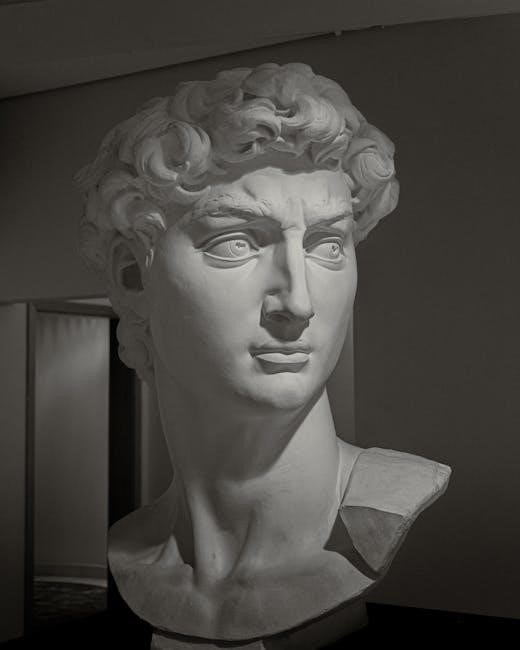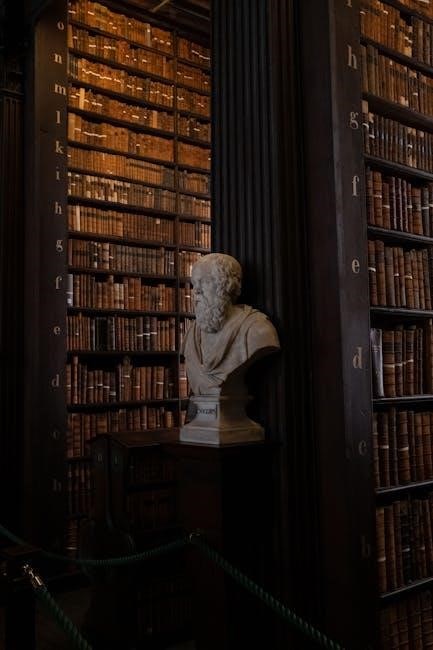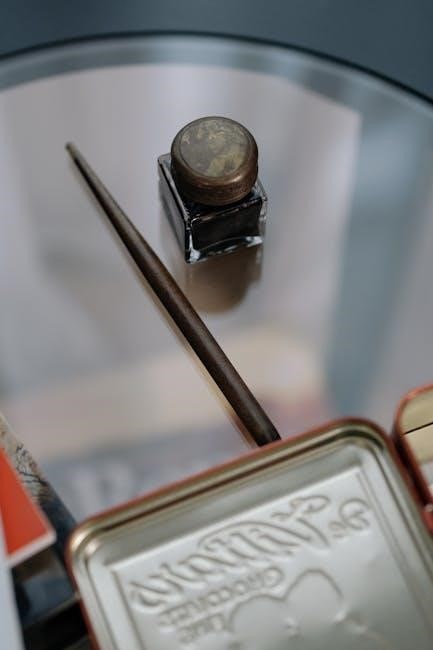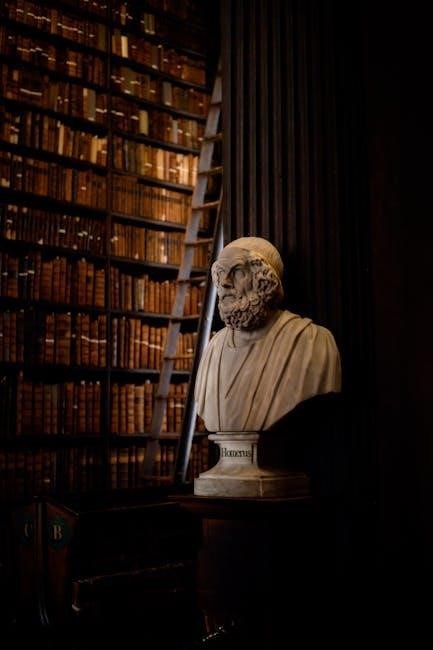AP Art History explores the nature, uses, and meaning of art, blending history and culture. It develops critical thinking, analysis, and global art perspectives, preparing students for advanced studies.
Overview of the AP Art History Course
The AP Art History course is designed to explore the nature, uses, and meaning of art across cultures and throughout history. It examines how art reflects and shapes human experiences, beliefs, and values. The curriculum spans a broad timeline, from ancient to contemporary art, emphasizing global perspectives and cultural contexts. Students analyze artworks, architectural styles, and artistic movements, developing critical thinking and interpretive skills. The course encourages the ability to connect art to historical events, social structures, and intellectual traditions. By studying diverse artistic traditions, students gain a deeper understanding of global cultures and their contributions to the visual arts. The course culminates in an exam that assesses knowledge of key artworks, historical periods, and the ability to analyze and interpret art effectively.
Significance of Studying Art History
Studying art history fosters critical thinking, cultural understanding, and analytical skills. It helps students appreciate how art reflects societal values, beliefs, and historical contexts. By exploring diverse cultures and time periods, learners gain a global perspective, enhancing empathy and cultural awareness. Art history also develops skills in visual analysis, research, and argumentation, which are valuable in various academic and professional fields. Additionally, it encourages students to consider the role of art in shaping identities and addressing social issues. The study of art history prepares individuals to engage thoughtfully with the world, fostering a deeper appreciation for creativity and its impact on human experience. This discipline is not just about memorizing facts but about understanding the stories and meanings behind artworks.

Key Components of the AP Art History Curriculum
The curriculum covers diverse art from global cultures, emphasizing cultural contexts, critical thinking, and historical analysis to foster deep understanding and appreciation of artistic traditions worldwide.
Understanding the Art History Timeline
Mastering the art history timeline is crucial for AP Art History, as it provides a chronological framework for understanding artistic developments. The timeline spans prehistory to contemporary art, covering key periods like Ancient Civilizations, Classical, Medieval, Renaissance, Baroque, Modern, and Contemporary art. Each era reflects cultural, social, and political influences that shaped artistic styles. Students should focus on identifying pivotal works, artists, and movements within these periods. For example, understanding the transition from Romanesque to Gothic architecture or the evolution of Renaissance humanism is essential. Organizing a timeline with images, dates, and historical contexts can help visualize connections. Additionally, recognizing how global cultures intersect and influence one another enhances comprehension. Regularly reviewing and memorizing this timeline will significantly aid in analyzing artworks and preparing for the exam.
Global Art and Its Cultural Context
Global art and its cultural context are central to understanding diverse artistic traditions. Each region, such as Asia, Europe, Africa, and the Americas, has unique styles shaped by history and society. These influences highlight how cultural identity is reflected and formed through art. The study of global art also reveals cross-cultural exchanges, such as trade routes and migrations, which have historically influenced artistic development. Analyzing these contexts is crucial for the AP exam, as it enhances critical thinking and the ability to contextualize works within their historical and cultural frameworks. By exploring global art, students gain a deeper appreciation of the interconnectedness of artistic expressions worldwide.
Major Art Movements and Periods
The AP Art History curriculum delves into significant art movements and periods, spanning ancient to contemporary art. From the Renaissance to Modernism, these periods highlight cultural shifts and artistic innovations. Students explore iconic styles like Gothic, Baroque, and Impressionism, analyzing their historical contexts. Understanding these movements is crucial for interpreting artworks and their societal influences. The curriculum also covers global traditions, such as African, Asian, and Indigenous art, emphasizing their unique contributions. By studying these periods, students gain a deeper appreciation of art’s evolution and its role in reflecting human experiences. This knowledge is essential for the exam, as it requires analyzing artworks within their specific historical and cultural frameworks. Mastering these movements is key to excelling in the course and developing a comprehensive understanding of art history.

Preparing for the AP Art History Exam
Use a one-month study guide to review essential ideas and practice with sample questions. Understanding the exam structure and format is key to success.
Exam Structure and Format
The AP Art History exam is divided into two main sections: multiple-choice questions and free-response essays. The multiple-choice section tests knowledge of art historical concepts, styles, and cultural contexts. The free-response section includes essay questions that require in-depth analysis of specific artworks and their historical contexts. Additionally, there is a separate section for analyzing and interpreting images. The exam is timed, with specific allocations for each section. Students are expected to demonstrate critical thinking, analytical skills, and the ability to connect artworks to their broader historical and cultural frameworks. Understanding the format and timing is crucial for effective preparation and time management during the exam.
Study Tips and Strategies
To excel in AP Art History, develop a structured study plan focusing on the art timeline and cultural contexts. Break down the vast timeline into manageable periods, using flashcards for key terms and artists. Practice analyzing images using the “language of art history” to identify styles and techniques. Engage with online resources like Smarthistory guides for in-depth analyses and visual learning. Regularly review and test yourself with practice questions to reinforce memory. Join study groups to discuss interpretations and gain diverse perspectives. Prioritize understanding over memorization, connecting artworks to their historical and cultural contexts. Use active learning techniques, like sketching or writing about art, to deepen comprehension. Stay organized, track progress, and allocate time for revision to ensure mastery of the curriculum.
Practice Questions and Resources
Mastering AP Art History requires consistent practice and access to reliable resources. Utilize official study guides and online platforms offering practice questions to familiarize yourself with the exam format. Websites like Khan Academy and Smarthistory provide interactive tools and detailed analyses to enhance your understanding. Additionally, join study groups or forums to collaborate with peers and gain diverse insights. Regularly reviewing practice exams will help identify strengths and areas needing improvement. Supplement your studies with flashcards for key terms and artists. Finally, leverage customizable study plans to stay organized and focused, ensuring comprehensive preparation for the AP Art History exam.

Essential Art Historical Concepts
Mastering art analysis, interpretation, and historical contexts is crucial. Understanding styles, techniques, and cultural influences enhances your ability to interpret artworks across periods and cultures effectively.
Art Analysis and Interpretation
Art analysis and interpretation are core skills in AP Art History, focusing on understanding artworks’ composition, color, and symbolism. Students learn to critically examine pieces, considering their historical and cultural contexts. This involves identifying artistic styles, techniques, and the artist’s intent. Effective interpretation requires connecting visual elements to broader themes, such as religious, political, or social influences. Developing these skills enhances students’ ability to think critically and communicate insights clearly. By analyzing works from diverse periods and cultures, students gain a deeper appreciation of art’s role in reflecting and shaping human experiences. Regular practice with images and texts helps refine these skills, preparing students for in-depth essays and discussions during the exam.
Historical Contexts of Art
Understanding the historical contexts of art is essential for analyzing its meaning and significance. Art is deeply rooted in the social, political, and cultural conditions of its time. By studying historical contexts, students can interpret artworks as reflections of their era, revealing insights into human experiences, beliefs, and values. For example, Renaissance art often symbolized religious devotion and humanism, while modern art might address contemporary issues like identity or technology. AP Art History encourages learners to explore how historical events, cultural traditions, and societal norms influence artistic production. This skill enables students to connect artworks to broader historical narratives, fostering a deeper appreciation of art as a mirror of human history and a tool for storytelling across time and place.
Artistic Styles and Techniques
Understanding artistic styles and techniques is crucial for analyzing works in AP Art History. From painting to sculpture and architecture, each style reflects cultural and historical contexts. Techniques like perspective, composition, and medium usage define movements such as Renaissance, Impressionism, and Abstract Expressionism. Analyzing these elements helps students interpret artworks effectively, preparing them for the AP exam. By studying how artists apply techniques, students gain insights into the creative process and historical influences, enhancing their ability to critically evaluate art. This knowledge is vital for constructing well-supported arguments in essays and analyses, demonstrating a deep comprehension of art history. Mastering these concepts ensures a strong foundation for success in the course and exam.

Additional Resources for Success
Utilize textbooks like Smarthistory guides, online platforms for interactive learning, and join study groups to enhance understanding and preparation for the AP Art History exam effectively.
Recommended Textbooks and Guides
Several textbooks and guides are essential for success in AP Art History. The official AP Art History Course and Exam Description provides a comprehensive overview of the curriculum. Gardner’s Art Through the Ages and Kleiner’s Gardner’s Art Through the Ages are widely recommended for in-depth analysis of art historical periods. Smarthistory guides, available online, offer detailed insights into key artworks and artists. Additionally, The AP Stylebook is useful for writing and citation guidance. Online platforms like Khan Academy and CollegeBoard also provide free study resources. Supplementing with textbooks like Art History by Marilyn Stokstad ensures a well-rounded understanding. These resources collectively aid in mastering the course material and preparing for the exam effectively.
Online Platforms for Art History Learning
Online platforms offer invaluable resources for AP Art History students. Smarthistory provides comprehensive guides covering the entire curriculum, with downloadable materials for easy access. Khan Academy and Coursera feature courses and tutorials that break down complex concepts. The College Board’s official website offers practice exams, study tips, and detailed course outlines. Additionally, platforms like Quizlet and Flashcards Deluxe enable students to memorize key terms and concepts effectively. These tools foster critical thinking, analysis, and a deeper understanding of global art history, making exam preparation more manageable and engaging. By leveraging these resources, students can enhance their learning experience and achieve success in the AP Art History exam.
Study Groups and Community Engagement
Study groups and community engagement are invaluable for mastering AP Art History. Collaborating with peers fosters deeper understanding and shared insights. Online platforms and forums connect students globally, enabling resource exchange and discussion. Local art events, museum visits, and workshops enrich learning by providing hands-on experiences. Engaging with art historians and professionals through webinars or lectures offers unique perspectives. Additionally, joining study groups on social media or educational apps can enhance preparation. Active participation in these communities builds confidence, clarifies concepts, and fosters a supportive environment. By leveraging these opportunities, students can gain practical experience and stay motivated throughout their AP Art History journey.
